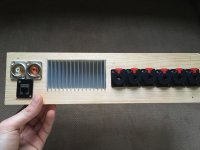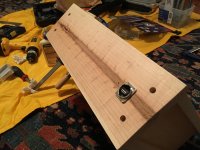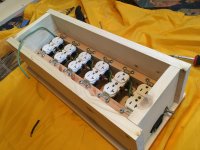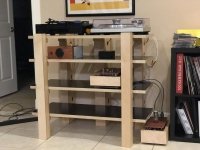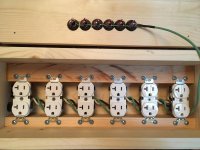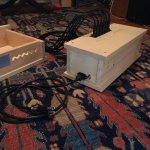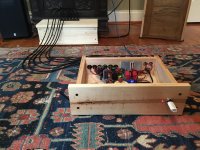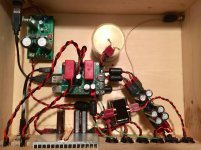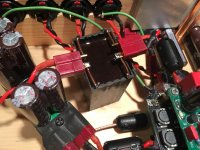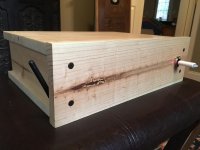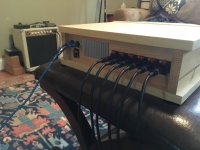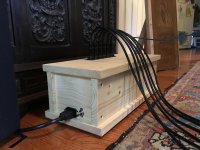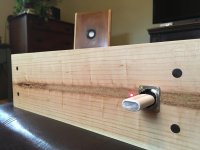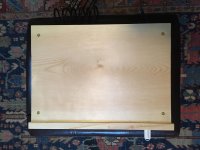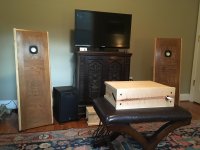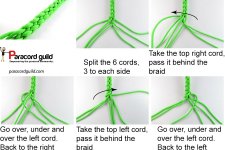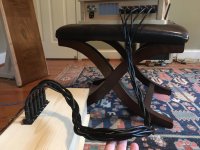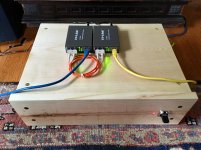Hi Sergi,
Thanks for letting me know you enjoy it!
It's a win-win for me: I had fun designing and building these for my own use, and when others enjoy them, well, that's just awesome.
Thanks for letting me know you enjoy it!
It's a win-win for me: I had fun designing and building these for my own use, and when others enjoy them, well, that's just awesome.
Finally began building a case for my Garman DAC RPi player. Lots of fun with the Forster bits and jigsaw today.
All the 1/4" jacks are for isolated DC feeds coming in from separate Jameco linear supplies. The heat sink is for the LT3042 board that feeds the RPi.
All the 1/4" jacks are for isolated DC feeds coming in from separate Jameco linear supplies. The heat sink is for the LT3042 board that feeds the RPi.
Attachments
Finally began building a case for my Garman DAC RPi player. Lots of fun with the Forster bits and jigsaw today.
All the 1/4" jacks are for isolated DC feeds coming in from separate Jameco linear supplies. The heat sink is for the LT3042 board that feeds the RPi.
Nice work! 6 separate supplies? haha
Yeah, it's ridiculous. Here's the diagram of the power and grounding scheme for the various boards inside. Only change to this is that I won't actually be using a dedicated cable for the JSGT earth cable. That seemed too extreme...my power cables are all Canare TRS with an unused shield, so I'm just going to use one of the braided copper shields as the earth wire. A very patient friend schooled me on star grounding for this project 😉.Nice work! 6 separate supplies? haha
Attachments
Yeah, it's ridiculous. Here's the diagram of the power and grounding scheme for the various boards inside. Only change to this is that I won't actually be using a dedicated cable for the JSGT earth cable. That seemed too extreme...my power cables are all Canare TRS with an unused shield, so I'm just going to use one of the braided copper shields as the earth wire. A very patient friend schooled me on star grounding for this project 😉.
Haha, the diagram is helpful, to visualize the insanity, haha.
@stellarelephant - that is far more ambitious than anything I ever imagined! I'm honored to be a part of it, and can't wait to see the pics when it's all done!
Made some progress on the separate PSU box today. Its a glorified power strip for plugging in all my Jameco wall warts, with an IEC inlet, switch, and 6x 1/4" jacks in the lid for DC out.
Have you seen the fofelix power filter group buys? I bet you could fit one in there. I've built a few of them, and really like them. My new equipment rack is going to get a pair built in to the bottom, when I get off my butt and knock that out 🙂
Attachments
Nice. That filter looks like something that could go in the wall, too. I tried a simple CLC filter in front of my old power strip for this DAC, and couldn't hear any difference. Which surprised me...because I can clearly hear differences between power supplies. Maybe I have clean AC?
Nice. That filter looks like something that could go in the wall, too. I tried a simple CLC filter in front of my old power strip for this DAC, and couldn't hear any difference. Which surprised me...because I can clearly hear differences between power supplies. Maybe I have clean AC?
You might, I sure as heck don't. 🙂
I think it would fit in a big duplex box in the wall, not sure about cooling requirements. I can't remember off-hand.
The power box is up and running. I drilled a few ventilation holes just under the lid on the back. I am using these high current model aviation "Deans" connectors (which Greg Stewart turned me on to) for linking the wall warts to the 1/4" jacks, and I will be using more on the RPi end. I love the easy-swap modular nature of the RPi as a music player, and I'm extending that theme to the power components as well. Perhaps I'll attempt a six strand round braid to tidy up the cable bundle? Hoping to stuff the player box tonight.
Attachments
Last edited:
Attachments
Last edited:
That looks awesome! Plus I love that I can see your Monoprice guitar amp in the background of one pic. 🙂
Since your enclosures are wood, have you thought about lining their interiors with something conductive, like copper tape, and routing that to earth? Unlikely to make an audible difference, but the shielding might give you some warm fuzzy feelings.
Since your enclosures are wood, have you thought about lining their interiors with something conductive, like copper tape, and routing that to earth? Unlikely to make an audible difference, but the shielding might give you some warm fuzzy feelings.
Thanks, Matt! I have indeed thought about copper foil lining. As is, the output is very quiet. The transformers are a few feet away now, and the RPi is modified with an external antenna. I also have ferrites clipped onto every power lead just before the load. And yet...that extra bit of "warm fuzzy feeling" always beckons 🙂 I still have to finish building up the newest revision of this DAC, for instance! But I think I'll rest on my laurels a few days, first. 😀
Ethernet vs WiFi for RPi audio
Today I am trying something I should have tried a long time ago...using a wired LAN connection instead of WiFi for controlling Volumio. I never stream music from NAS or internet streaming services--I like the tidiness of storing my music collection on a local disk. So I feed the player music from a Micro SD card into the RPi via USB.
As such, the network traffic must be quite light...I'm guessing a few kilobytes per second, as the RPi broadcasts some simple UI data and listens for song transport commands. So I assumed that I would not be able to hear any difference between Ethernet or WiFi. Wrong!
I just updated Volumio and was delighted to find some expanded control available in the preference panes. There are options to disable some Volumio system processes, and, FINALLY, a handy toggle switch for WiFi. After a few tests back and forth, I feel that disabling WiFi sounds cleaner. This is with an isolator and reclocker in place.
Greg Stewart has kindly provided me with a pair of fiber media converters to test with my system. I've just hooked them up. So I'm now listening for a difference between a direct wired connection to my router and an optically isolated connection. If there is one, it is subtle. 🙂
Today I am trying something I should have tried a long time ago...using a wired LAN connection instead of WiFi for controlling Volumio. I never stream music from NAS or internet streaming services--I like the tidiness of storing my music collection on a local disk. So I feed the player music from a Micro SD card into the RPi via USB.
As such, the network traffic must be quite light...I'm guessing a few kilobytes per second, as the RPi broadcasts some simple UI data and listens for song transport commands. So I assumed that I would not be able to hear any difference between Ethernet or WiFi. Wrong!
I just updated Volumio and was delighted to find some expanded control available in the preference panes. There are options to disable some Volumio system processes, and, FINALLY, a handy toggle switch for WiFi. After a few tests back and forth, I feel that disabling WiFi sounds cleaner. This is with an isolator and reclocker in place.
Greg Stewart has kindly provided me with a pair of fiber media converters to test with my system. I've just hooked them up. So I'm now listening for a difference between a direct wired connection to my router and an optically isolated connection. If there is one, it is subtle. 🙂
Attachments
I've been lurking around some of the TDA1387 threas for a while, primarily Abraxalito's PhiDAC, LingDAC etc. - in fact Matt has previously supplied me with a couple of PhiDAC kits that a friend is using to develop his DIY pick and place project.
I think it's time I added a TDA-based DAC to my collection with a starting point of one of Matt's original 'Front End' PCBs. I'll use a JLSounds I2SoverUSB module to deliver the I2S and I have a spare Salas Reflektor-D power supply I can use, which brings me to my first question; can anyone tell me what current the 'Front End' TDA1387 board requires from its 5V supply (assuming its fully populated with eight DAC chips).
Something else from a few years back that interested me but never got followed up were the Lampizator I/V stages so I thought I might try one of those with this DAC too. As the DAC can operate in balanced mode I've been looking at the Lampizator schematic that was originally put together over a decade ago for the early ESS-based Buffalo DACs. Here's the schematic and a link to the web page (the I/V stage is down near the bottom of the page).

BuffaloDAC
Can anyone tell me if this is a good/bad idea and whether I need to change any of the component values to suit the TDA1387 DAC? I know the ESS DACs have very healthy output levels and I'm wondering if the TDA1387 board, even with the paralled DAC chips, will deliver sufficient current. Please excuse my questions - I'm pretty good at making stuff but I'm no electronics engineer.
Thanks.
I think it's time I added a TDA-based DAC to my collection with a starting point of one of Matt's original 'Front End' PCBs. I'll use a JLSounds I2SoverUSB module to deliver the I2S and I have a spare Salas Reflektor-D power supply I can use, which brings me to my first question; can anyone tell me what current the 'Front End' TDA1387 board requires from its 5V supply (assuming its fully populated with eight DAC chips).
Something else from a few years back that interested me but never got followed up were the Lampizator I/V stages so I thought I might try one of those with this DAC too. As the DAC can operate in balanced mode I've been looking at the Lampizator schematic that was originally put together over a decade ago for the early ESS-based Buffalo DACs. Here's the schematic and a link to the web page (the I/V stage is down near the bottom of the page).

BuffaloDAC
Can anyone tell me if this is a good/bad idea and whether I need to change any of the component values to suit the TDA1387 DAC? I know the ESS DACs have very healthy output levels and I'm wondering if the TDA1387 board, even with the paralled DAC chips, will deliver sufficient current. Please excuse my questions - I'm pretty good at making stuff but I'm no electronics engineer.
Thanks.
- Home
- Source & Line
- Digital Line Level
- tda1387 dac pcb "front end"
